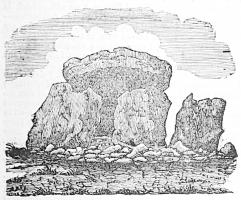Text this colour links to Pages. Text this colour links to Family Trees. Text this colour are links that are disabled for Guests.
Place the mouse over images to see a larger image. Click on paintings to see the painter's Biography Page. Mouse over links for a preview. Move the mouse off the painting or link to close the popup.
County Antrim is in Province of Ulster.
The Druid Stone aka Mount Druid Cromlech is also in Prehistoric Ireland.
When the rectory of Ballintoy was built in the late eighteenth century it was named "Mount Druid House". The Minutes of Ballintoy Church record that: "'In May 1789 Mr. Trail began to build a Glebe House … changing the name of the place from Magherabuy to Mount Druid, on account of a Druid's temple [The Druid Stone aka Mount Druid Cromlech [Map]] now standing on the glebe'.

Dublin Penny Journal 1833-34. The Druid Stone aka Mount Druid Cromlech [Map].
This memorial of the superstitious customs of our country, previous to the introduction of Christianity, stands on an eminence in the grounds of the Rev. Robert Trail, of Ballintoy, in the immediate vicinity of the Giants' Causeway, in the county of Antrim.
On 7th February 1832 Samuel Wilson was born at Ballycloughan.
The Broad Stone aka Craigs Passage Tomb is also in Prehistoric Ireland.
The Broad Stone aka Craigs Passage Tomb [Map] features a big capstone on seven upright stones. Lightning broke the capstone in 1976. It was restored in 1985, and excavation revealed that the chamber was the remnants of a passage tomb at the time.

Dublin Penny Journal 1833-34. THE BROAD STONE [Map], PARISH OF FINVOY, COUNTY OF ANTRIM.
In the recess of a mountainous ridge, called the Craigs, the surface of which is highly diversified by wild flowers and heath, dividing into serpentine walks its carpet of the richest green, stand the ruins of a magnificent temple, supposed to have been of druidical erection, called the: Broad-stone. The altar, or covering stone, was formerly, supported by five others, upwards of four feet in height; three of these have been taken away within memory, leaving one end of the altar on the ground, and the other, leaning against the remaining supporters, as seen in the annexed view.
This stone is ten feet in length, nine feet in breadth, by one thick, beneath which is said to have been formerly a chamber communicating with two smaller apartments, extending northward, and covered with stone. At present no certainty on this head can be obtained, as where those excavations are said to have been, are filled up. Adjoining, on the north-cast, is a round cavity about two feet in diameter, neatly faced with stone, called the giant’s-pot, which is said to have extended into the adjoining chambers. The ruinous state of the structure frustrates all researches as to this statement, which, however, would seem to have been true. On the south of the altar is a large stone detached from the supporters; and on the opposite side stood formerly another of similar dimensions: the probable use of these has not been even surmised. Adjoining, on the north-west, are the remains of a stone circle; and vestiges of a similar erection are seen on the south-east. These, as well as the altar, appear to have been formerly encompassed by a circle of large stones, forty-three feet in diameter; the greater part of the ground within this enclosure is said to have been excavated.
According to tradition, an ancient giant lies here interred; the Broad-stone is said to mark out his grave; and a little northward are three stones nearly seven feet high, said to point out the tombs of an equal number of his followers.
![]() Become a Member via our Buy Me a Coffee page to read complete text.
Become a Member via our Buy Me a Coffee page to read complete text.
Dublin Penny Journal 1833-34. Midway from Ballymena to Ballymoney, somewhat to the left, are seen the Craigs rocks, or Fort of Craigs, which form a square of nine thousand feet in area, with a very deep trench, close to which are three pillars erect and tapering, supposed to have bean placed there in honour of some valiant chieftan slain in battle; and but a short distance from them, in the hollow of a high and craggy ridge, there is a cromlech [The Broad Stone aka Craigs Passage Tomb [Map]], or druidical altar—a slab of black heavy stone, one foot in thickness, ten feet long, and eight broad, originally placed upon five supporters. Beneath this is a chamber which communicates with two others, about seven feet square, and arched over—the whole standing within a circle of one hundred and thirty five feet in circumference, the ground underneath having formerly been hollowed into a kind of cavern. A writer in Mason's Statistical Survey, speaking of this place, observes that it must have been the theatre of great events: in former times; that it posesses more remains of antiquity than he has any where seen in the same space of ground. The place where the altar is erected is lonely; and awful—it induces thought, and brings back the memory to former days, over which the mind broods with pent e pleasure. Here Fingal and his clans of Mourné and Beiskeré may have displayed their valour—Torgis and his Scandinavians committed their ravages—Sourleboy (i.e. Yellow Chorley) and his Scotch played off their stratagems—or De Courcey and his English showed forth their heroism. All are now gone; a total change of laws, manners, religion, and war, has taken place—and a rational religion and mild government have blessed us with peace and know ledge.—See "Northern Tourist," published fs Curry and Co.
On 20th March 1856 John Lavery was born. He was baptised at St Patrick's Church Belfast.
In 1491 Gilbert Debenham (age 59) was appointed Constable of Carrickfergus Castle. He also received the office of Keeper of the Royal mines in Ireland.
In or before 1624 Charles Egerton of Knockfergus was appointed Constable of Carrickfergus Castle.
On 30th January 1817 Baldwin Leighton 6th Baronet (age 70) was appointed Governor of Carrickfergus Castle which position he held until he died in 1828.
On 5th October 1844 George Chichester 2nd Marquess Donegal (age 75) died at Ormeau, County Donegal. He was buried at St Nicholas' Church, Carrickfergus. He was buried at St Nicholas' Church, Carrickfergus, County Antrim. His son George (age 47) succeeded 3rd Marquess Donegal. Harriet Anne Butler Marchioness Donegal (age 45) by marriage Marchioness Donegal.
On 2nd June 1567 Shane O'Neill (age 37) was assassinated at Castle Cara.
In 1713 Jane Ormsby (age 33) died at Castle Upton.
On 13th August 1667 Bishop Jeremy Taylor (age 54) died at Lisburn, Antrim. He was buried in Dromore Cathedral.
On 3rd February 1732 Francis Seymour-Conway 1st Baron Conway (age 52) died at Lisburn, Antrim. His son Francis (age 13) succeeded 2nd Baron Conway of Ragley in Warwickshire, 2nd Baron Conway of Killultagh in Antrim.
Before 25th July 1575 Walter Devereux 1st Earl Essex (age 33) ordered Francis Drake (age 35) and John Norreys (age 28) to confront Scottish refugees on Rathlin Island. On 25th July 1575 the garrison surrendered.
All About History Books
The Chronicle of Walter of Guisborough, a canon regular of the Augustinian Guisborough Priory, Yorkshire, formerly known as The Chronicle of Walter of Hemingburgh, describes the period from 1066 to 1346. Before 1274 the Chronicle is based on other works. Thereafter, the Chronicle is original, and a remarkable source for the events of the time. This book provides a translation of the Chronicle from that date. The Latin source for our translation is the 1849 work edited by Hans Claude Hamilton. Hamilton, in his preface, says: "In the present work we behold perhaps one of the finest samples of our early chronicles, both as regards the value of the events recorded, and the correctness with which they are detailed; Nor will the pleasing style of composition be lightly passed over by those capable of seeing reflected from it the tokens of a vigorous and cultivated mind, and a favourable specimen of the learning and taste of the age in which it was framed." Available at Amazon in eBook and Paperback.
In 1642 Duncan Campbell 2nd Baronet (age 45) commanded soldiers to kill the local Catholic MacDonalds of Rathlin Island, near relatives of their arch clan enemy in the Scottish Highlands Clan MacDonald.
On 2nd February 1645 Duncan Campbell 2nd Baronet (age 48) was captured and killed at the 1645 Battle of Inverlochy possibly in retaliation for his killing of members of the MacDonald clan at Rathlin Island three years before. His son Dugald (age 20) succeeded 3rd Baronet Campbell of Auchinbreck.